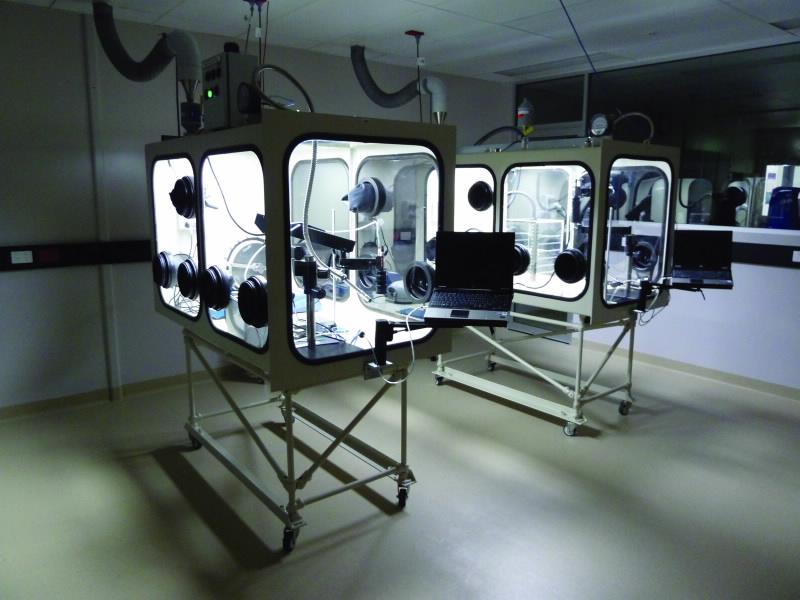
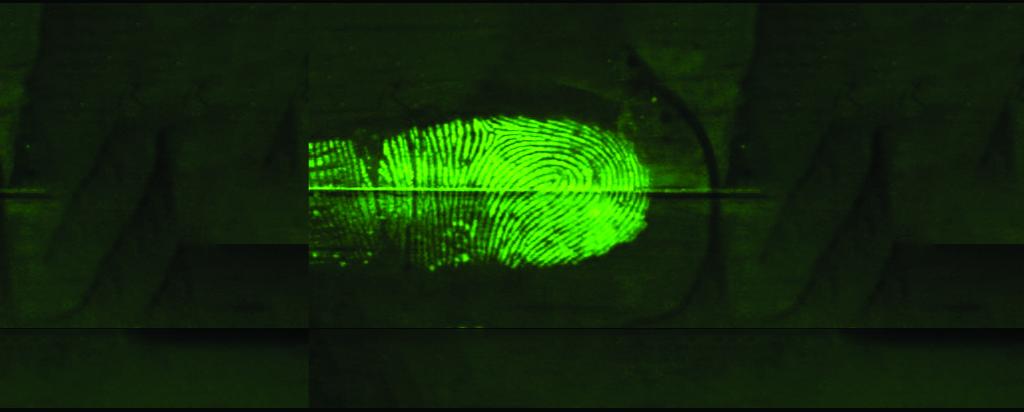
Published on the 16th February 2012 by ANSTO Staff
The collection, handling and analysis of forensic evidence from a radiological crime scene presents significant challenges. The potential for the use of radioactive materials in a malevolent act has been heightened in recent years, and it is highly likely that some or all of the physical evidence recovered after such an event may have been exposed to ionising radiation or contaminated with radioactive material.
 |
| Glove boxes used for examination of forensic trace evidence in ANSTO’s Nuclear Forensics Research Facility. |
Authorities need a way to safely collect, handle and examine potential evidence contaminated with radioactive material. This research explores the impact that high-energy alpha particles have on traditional evidence types including fingermarks, DNA, hairs and fibres.
The study also assesses existing methods and develops new forensic procedures for handling and processing traditional evidence contaminated with alpha emitting radioactive material.
What is nuclear forensics?
Nuclear forensic science, internationally referred to as ‘nuclear forensics’, is the comprehensive scientific analysis of nuclear or other radioactive materials or contaminated materials in the context of a State’s obligations under international law, including criminal or civil proceedings [1].
The Nuclear Forensics Research Facility at ANSTO has been established to accommodate the requirements for handling radioactive or nuclear material or contaminated materials that require forensic exploitation.
A traditional forensic laboratory does not possess the facilities to handle radioactive material and therefore a facility such as that developed at ANSTO is required to ensure a national capacity to deal with a radiological crime scene.
What is the impact of alpha radiation on forensic trace evidence?
Alpha radiation is a type of ionising radiation in the form of particles, namely helium nuclei, with very low penetration but high energy. If contaminants containing alpha-particle emitters are inhaled or ingested, they can cause damage to cells.
We set out to explore the impact of alpha-radiation on forensic trace evidence. ANSTO’s 2 MV Tandetron STAR accelerator was used to expose fingermarks, hairs and fibres to helium ions, representative of the energies and doses that may occur through exposure to common alpha-emitting sources.
It was identified that alpha radiation inflicted damage on forensic trace evidence that may affect the ability to analyse and interpret the evidence types studied.
Fingermarks
Exposure of a porous surface such as paper to alpha radiation, either before or after the deposition of fingermarks, was detrimental to the ability to develop fingermarks when doses were greater than 250 kGy.
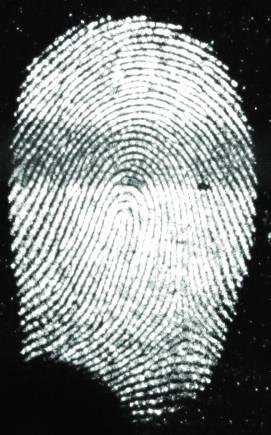 | 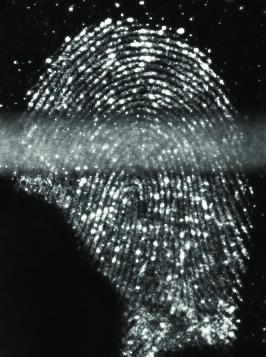 | 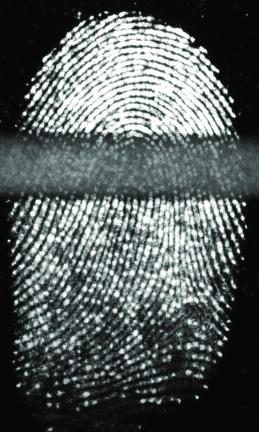 |
| Fig 1. Developed (using indanedione-zinc) fingermarks on paper exposed to alpha radiation at (l-r) 50, 250, and 1000 kGy prior to fingermark deposition. |
In Fig. 1, the alpha-beam track is observed through the centre of the developed fingermark. It can be seen that the damage incurred at 1000 kGy significantly impedes the ability to recognise identifiable features that are required for fingermark comparison.
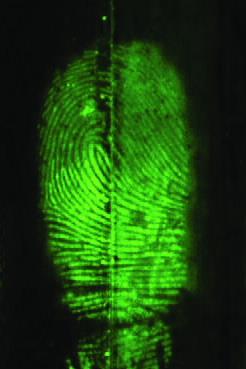 | 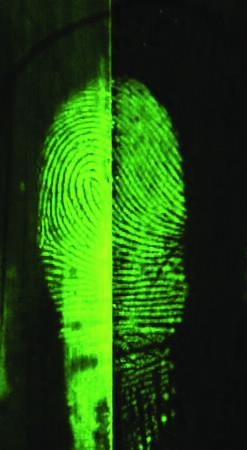 | 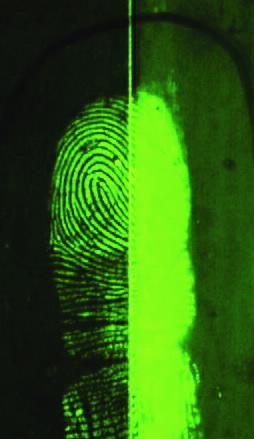 | 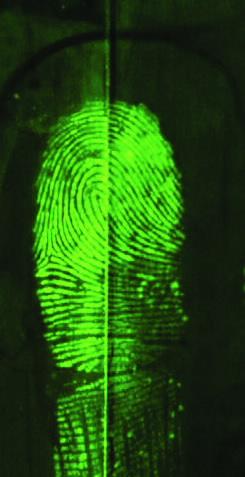 |
| Fig 2. Fingermarks on glass developed using cyanoacrylate fuming with Rhodamine 6G stain solution. Imaged under 505nm Polilight (R) and a KV550 long-pass barrier filter. |
Hairs and fibres
Using a range of analytical techniques, it was observed that the surface and chemical structures of hairs and fibres were mostly resistant to alpha radiation at the energies and doses employed. Minimal effects were identified in dyed hair as well as acrylic, cotton and wool fibres. Nylon and polyester fibres showed significant resistance to alpha radiation-induced damage.
What is the impact of contamination on forensic trace evidence?
We have also been able to demonstrate effective laboratory methods for the processing of evidence contaminated with radioactive material. In the nuclear industry, glove boxes are commonly used for the isolation of alpha contamination.
Although external contamination with alpha-emitting radioisotopes poses little health risk (due to their low penetration), should they enter the body then the high ionising power of alpha particles means that significant cellular damage may occur.
A glove box enables the handling of contaminated evidence whilst maintaining a safe user environment, but the restricted environment of a glove box was particularly challenging for examining contaminated evidence. However the trialled techniques proved successful for most evidence types that were investigated.
Fingermarks
The introduction of two bench-top fingermark development and enhancement techniques to the glove box was successful. To allow these techniques to be employed, an essential modification to the glove box was the inclusion of a variable wavelength light source (Polilight®) and camera system to allow image capture in situ.
The first technique, for non-porous surfaces such as glass, requires superglue to be heated to 100oC. This produces cyanoacrylate fumes which react with the fingermark residue to form a white deposit along the ridges of the fingermark.
To visualise the fingermark, a dye, known as Rhodamine 6 stain solution, is applied. This enables visual enhancement using specific lighting and filters. To employ this technique in the glove box, a modified fuming chamber with a hotplate was retrofitted and a secondary ventilation system installed to vent the cyanoacrylate fumes.
The second technique requires the porous sample (paper) to be submerged in a prepared solution, dried and then heated in a heat press. Due to size constraints imposed by the glove box a commercially available hair straightener was successfully substituted for the heat press.
Comparison of the results of the bench-top (C) and glove box (GB) techniques for cyanoacrylate fuming is provided.
Fibres
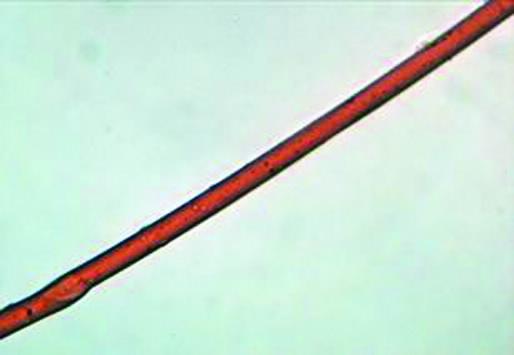 | 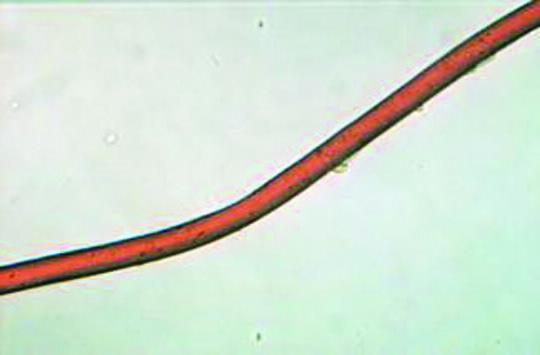 | 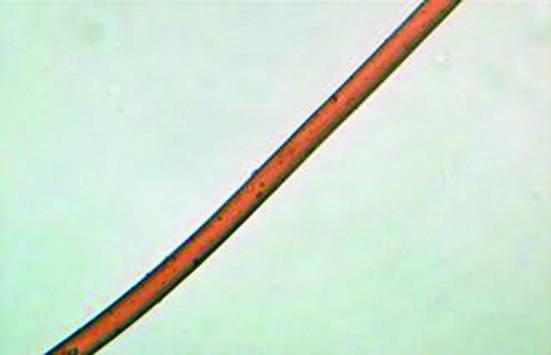 | 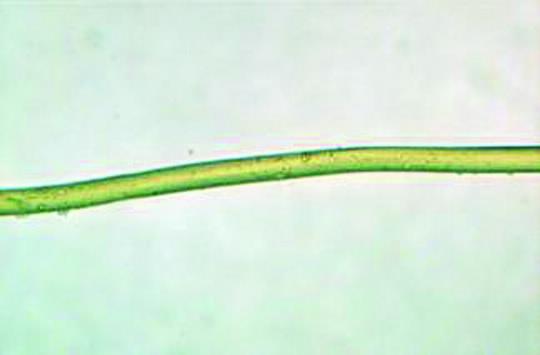 |
| Fig 3. Colour changes observed in red polyster fibres with increasing doses. Shown fibres exposed to (l-r)0, 10, 100, 1000 kGy. |
In general, the contamination and the ensuing decontamination of fibres had no impact on subsequent forensic analysis. The decontamination procedure, an optimised technique developed in previous research [2], was the immersion of the sample in a detergent and water solution (2% Decon 90™) and cleaning for 5 minutes using ultrasonication to loosen particles adhering to the sample surface, before rinsing.
This procedure resulted in satisfactory decontamination without damaging the fibre.
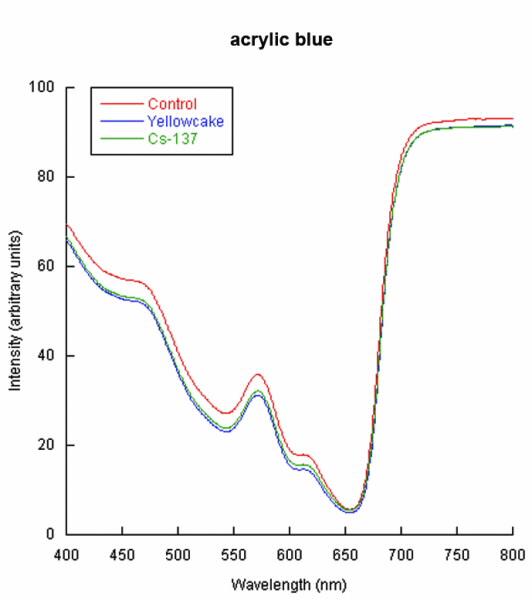 | 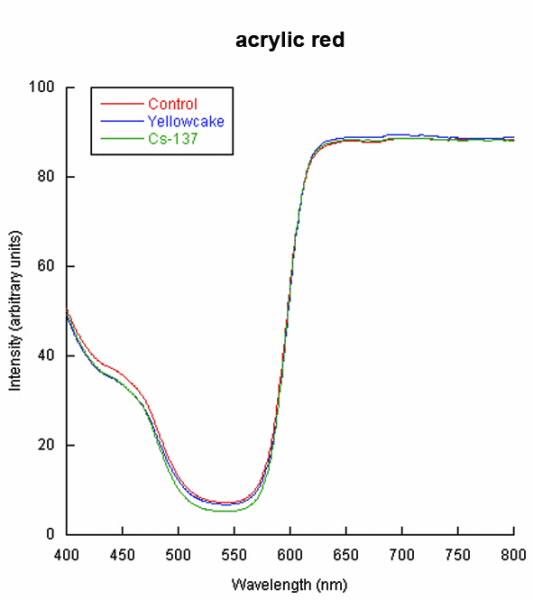 |
| Fig 4. Microspectrophotometry spectra of a blue acrylic fibre (left) ana red acrylic fibre (right). The control sample is overlayed with the treated samples showing no discernible difference as a result of contamination and subsequent decontamination. |
What about other types of radiation?
In 2007, we completed a project assessing the impact of gamma radiation on forensic trace evidence [3-7], identifying the impact on specific evidence types at particular dose intervals.
These results indicated that some types of evidence, such as human hair, paint chips and fingermarks, are not degraded by gamma radiation whilst others, such as fibres, glass and trace DNA, demonstrated damage to various degrees.
Fig. 5 shows the impact gamma radiation had on red polyester fibres as a function of dose: the intensity of the colour of the red polyester fibre diminishes with increasing dose, almost to a point of bleaching at the 1000 kGy exposure.
This highlights the importance of understanding the effects of radiation on forensic evidence.
Acknowledgements
This work is supported by the Department of Prime Minister and Cabinet, National Security Science and Technology Branch, under contract PR07-0093, the Australian Federal Police and Australian Emergency Management.
Authors
Tegan Evans1, Daniel Brew1, Kaitlyn Toole1, Michael Colella1, Chris Lennard2, Claude Roux3, Simon Walsh4
1ANSTO, 2University of Canberra, 3University of Technology, Sydney, 4Australian Federal Police, Forensic and Data Centres
References
- Office of Nuclear Security, draft non-paper Development of National Nuclear Forensics Libraries, 2011, International Atomic Energy Agency: Vienna.
- Parkinson, A., Evans, T., Roux, C., Abbondante, S., Hill, D., and Colella, M., NSST 06-032 Project: The Assessment of Post-Incident Radiological Decontamination Materials, 2008, Australian Nuclear Science and Technology Organisation: Sydney.
- Abbondante, S.F., The Effect of Radioactive Materials on Forensic DNA Evidence: Procedures and Interpretation, 2009, University of Canberra.
- Colella, M., Evans, T., Parkinson, A., Roux, C., Lennard, C., Robertson, J., Abbondante, S., and Hill, D., NSST 06-031 Project: The Impact of Ionising Radiation on Forensic Trace Evidence, 2009, Australian Nuclear Science and Technology Organisation: Sydney.
- Colella, M., Parkinson, A., Evans, T., Robertson, J., Roux, C., The Effect of Ionizing Gamma Radiation on Natural and Synthetic Fibers and its Implications for the Forensic Examination of Fiber Evidence, Journal of Forensic Sciences, 56(3), 591-605 (2011).
- Parkinson, A., Colella, M. and Evans, T., The Development and Evaluation of Radiological Decontamination Procedures for Documents, Document Inks, and Latent Fingermarks on Porous Surfaces, Journal of Forensic Sciences, 55(3), 728-734 (2010).
- Colella, M., Parkinson, A., Evans, T., Lennard, C., Roux, C., The Recovery of Latent Fingermarks from Evidence Exposed to Ionising Radiation, Journal of Forensic Sciences, 54(3), 583-590 (2009).